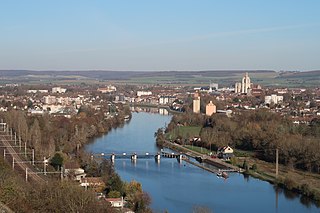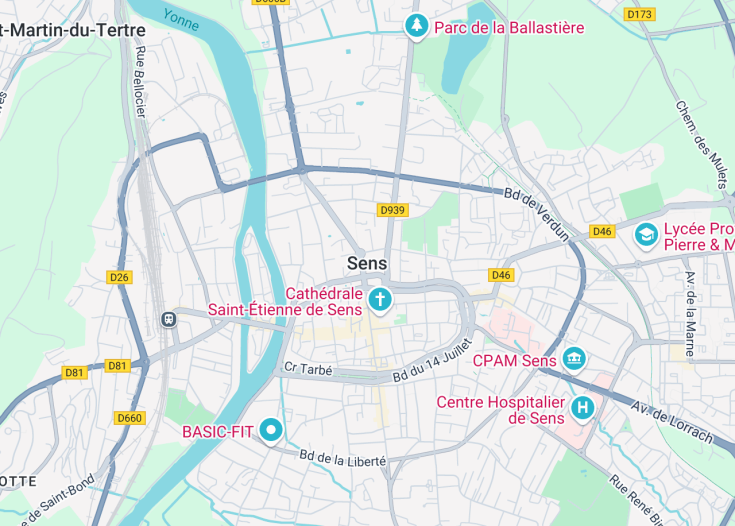Sens, located in the Bourgogne-Franche-Comté region of France, boasts a rich historical tapestry and breathtaking architecture. It’s especially renowned for its magnificent Sens Cathedral, one of the earliest Gothic buildings in the country. The city’s medieval charm is complemented by its scenic riverside setting along the Yonne River, making it an enchanting destination for history buffs and nature lovers alike. Sens offers a unique journey back in time with its well-preserved historic sites, traditional French markets, and winding cobblestone streets.
For an enriching experience, visit the Sens Cathedral early in the morning to enjoy the serene ambiance and the radiant morning light filtering through its stained glass windows.
Be sure to explore the local market held in the heart of Sens for a taste of regional specialties and a vibrant display of local culture and craftsmanship.
Top things to do & see in Sens
Select the following sights and activities to discover best tickets and tours available in Sens.
Sens: A Hidden Gem in the Heart of France
| Country | France |
| Time in Sens | GMT+1 |
| Language spoken | French |
| Population | 25,507 (source: latest municipal data) |
| Currency | Euro (€, EUR) |
| Airports |
|
Sens, a charming and historic town located in the Yonne department in north-central France, is a treasure trove of medieval architecture, religious history, and vibrant cultural heritage. Known for its remarkable Gothic cathedral, Sens Cathedral, the town is a significant spiritual and historical site. This age-old town was once the principal city of the Senones, a powerful Gallic tribe, making it abundant in historical significance.
Where is Sens?
Located in the Burgundy region of France, Sens is situated by the Yonne River, offering scenic beauty and a tranquil environment.
Distances:
| Route | Distance by car | Time by car |
|---|---|---|
| Paris to Sens | 125 km | 1h 15min |
| Lyon to Sens | 360 km | 3h 45min |
| Dijon to Sens | 175 km | 2h |
What is Sens famous for?
Aside from its historical center, Sens is famous for its culinary traditions which include wine and local gourmet cuisine, offering a sumptuous treat for visitors.
History
Ancient Origins (Before 1st Century AD)
The area around Sens, one of France’s oldest towns, was originally settled by the Senones, a Gallic tribe, who are believed to have arrived in the region around 600 BC. This early Celtic influence laid the foundational culture of the area, evident from artifacts and remnants found in archaeological digs.
Roman Era (1st Century AD – 5th Century AD)
Sens, known as Agedincum in Roman times, became a significant Gallo-Roman city. The town flourished due to its strategic location along the Yonne River, serving as a vital commercial and military hub. Many structures from this period, including parts of walls and gates, still stand as testaments to the city’s significant past during Roman rule.
Medieval Period (5th Century – 15th Century)
With the fall of the Roman Empire, Sens experienced a series of invasions but maintained its importance, largely due to the establishment of its bishopric in the 3rd century which later became one of France’s primatial sees. The Cathedral of St. Stephen, built from 1135 onwards, is a marvelous example of early Gothic architecture influenced by the nearby Abbey of St. Denis. The town became a religious center with the bishop holding significant power.
Modern Era (16th Century – Present)
The city continued to grow in the modern era, though it faced the devastations of various wars including the Hundred Years’ War and the French Wars of Religion. In contemporary times, Sens has embraced its rich heritage, preserving its historical sites and revitalizing its ancient structures, which now contribute significantly to its appeal as a tourist destination. During the 19th and 20th centuries, the town expanded beyond its medieval limits, developing the industrial sector along the Yonne River and adapting to modern urban challenges.
Visit Sens
What to see and do in Sens
Visitors to Sens will find a city rich in history and culture. The centerpiece is the Sens Cathedral, a pioneering Gothic structure that has stood since the 12th century. Beyond the cathedral, explore the streets of the old town to discover traditional timber-framed houses and the Palais Synodal, a medieval building once used for ecclesiastical meetings.
For a deeper understanding of local history, the Sens Museum complex, housed in the former archbishop’s palace, offers extensive exhibits ranging from Roman artifacts to Renaissance art. For outdoor activities, the Parc du Moulin à Tan provides a lovely setting for strolls and picnics near the city center.
Festivals and Events in Sens
Sens hosts several cultural events throughout the year, notably the Sens Music Festival, held every summer. This event transforms the city into a vibrant concert venue featuring classical and contemporary music performances. In the autumn, the ‘Foire de Sens,’ an annual fair with a lineage dating back to medieval times, offers a mix of local gastronomy, crafts, and entertainment.
Best time to visit Sens
The best time to visit Sens is from late spring to early autumn, ranging from May to September, when the weather is generally pleasant and mild, which is ideal for exploring the city’s outdoor attractions and attending the various events and festivals that take place during these months.
is Sens worth visiting?
Sens, with its rich historical tapestry and vibrant cultural scene, offers a unique blend of past and present, making it definitely worth a visit. The city’s architectural landmarks like the Sens Cathedral provide insights into the early Gothic architectural styles, while the local museums and galleries offer a dive into centuries of art and history.
However, visitors should be aware that the city’s charm lies in its tranquility and historical depth, which might not appeal to those seeking a more bustling, modern urban environment. Overall, for those interested in history and culture, Sens promises an enriching experience.









